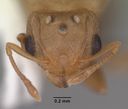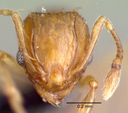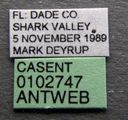Wasmannia
Wasmannia
Classification
- Phylum: Arthropoda
- Subphylum: Hexapoda
- Class: Insecta
- Order: Hymenoptera
- Superfamily: Formicoidea
- Family: Formicidae
- Subfamily: Myrmicinae
- Tribe: Attini
- Genus: Wasmannia
Pronunciation
How to pronounce Wasmannia: /wɑsˈmɑniə/
These audio files are automatically generated. While they are not always 100% accurate, they are a good starting point.
Images






Summary
Wasmannia auropunctata, or the little fire ant, is a small invasive species native to the Americas but now widespread in tropical and subtropical regions. It poses significant ecological and economic threats as a powerful predator and pest.
Physical Characteristics
Workers are monomorphic, ranging from 1-2mm, light to golden brown with a darker gaster. The petiole is hatchet-like, and the head has a distinct antennal scrobe. The body is covered with long, erect hairs and has long thoracic spines.
Identification Tips
Look for small, light to golden brown ants with a painful sting, featuring a distinct petiole and 11-segmented antennae with a clubbed end.
Habitat
Colonies are found under rocks, plant litter, and in disturbed habitats associated with humans, such as agricultural fields, residential areas, and forest edges.
Distribution
Originally from Central and South America; introduced to parts of Africa, Taiwan, North America, Puerto Rico, Israel, Cuba, St. Croix, and several Pacific Islands including Hawaii and the Galápagos Islands.
Diet
Generalist diet including other insects, decaying vegetation, seeds, plants, and honeydew from aphids; engages in mutualistic relationships with herbivorous insects.
Life Cycle
Queens reproduce through parthenogenesis, and workers are produced from fertilized eggs. Some clonal queens can produce offspring via automictic parthenogenesis.
Reproduction
Queens can reproduce asexually through parthenogenesis and sexually with males, producing both clonal and genetically diverse progeny.
Ecosystem Role
Predatory and decomposer role; can significantly impact native insect populations and local ecosystems.
Economic Impact
The presence of little fire ants in agricultural fields reduces crop yields and increases vulnerability to disease, harming agricultural sectors.
Health Concerns
Stings cause painful welts and can lead to blindness in pets if stung around the eyes. There is suspicion of a link between W. auropunctata and Florida keratopathy.
Collecting Methods
- Pitfall traps
- Sticky traps
- Visual inspection of habitats
Preservation Methods
- Ethanol
- Immersion in fixative
Evolution
Wasmannia was formerly placed in the subfamily Blepharidattini.
Similar Taxa
Misconceptions
The little fire ant's sting is sometimes underestimated due to their small size, but it can cause significant pain and injury.
Tags
- invasive species
- agriculture
- pest management
- ecology
- entomology